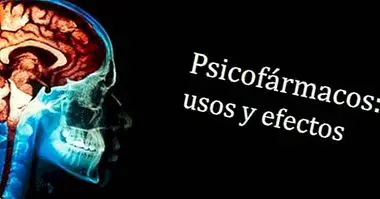Types of anxiolytics: the drugs that fight anxiety
The culture and society in which we live is characterized by a high level of dynamism and constant change, together with a high demand for the people who are part of it.
We are constantly being asked to be productive, proactive and farsighted , having to adapt both to the changes of the current society and to the possible situations that could happen in the future. For this reason we often worry about what might come, a concern that can lead to aversive emotional states of fear and tension for what might happen.
In this way, we can observe how disorders related to stress and anxiety are becoming more prevalent, with anxious problems being the most prevalent in the general population and in the clinic. In order to deal with this type of problems, different types of treatments have been developed and synthesized and, among them, at the pharmacological level, various types of anxiolytics have been synthesized .
Analyzing the problem to be treated: anxiety
The different types of anxiolytics that will be discussed in this article have several points in common, but the main one is the type of problem they treat: anxiety.
While most people know what it is and have in fact experienced anxiety throughout their lives, it is a phenomenon that is often difficult to define. It is considered anxiety to that state of emotional distress that arises without there being an immediate stimulus or danger that generates it , being the forecast of a future phenomenon what causes this reaction. Subjects suffering from anxiety have a high level of activation along with a high negative affectivity.
Although its origin is usually cognitive, the effects it produces can also be translated at the physiological level, producing reactions such as tachycardia, physical tension or sweating. It also causes effects at the behavioral level, such as the avoidance of situations that could lead to what causes anxiety. For example, fearing that a phenomenon that happened in the past might happen again may cause us to avoid similar situations in order to make sure that this is not possible.
Therefore, taking into account the discomfort it causes and the fact that it can even invalidate important aspects of our life (as for example in cases of individuals with agoraphobia), seeking a treatment that alleviates these problems has led to the creation of various treatments, as Anxiolytics in the case of pharmacological treatments .
- Related article: "The 7 types of anxiety (causes and symptoms)"
Main types of anxiolytics
The general function of anxiolytics is to induce a decrease in activity, through a depressant action on the nervous system. To this end, most types of anxiolytic act on gamma-aminobutyric acid or GABA and its receptors, enhancing the inhibitory action of this neurotransmitter.
Despite this, in recent times An increase in the use of drugs with action on serotonin has been observed , leading to use antidepressants such as SSRIs as a drug of choice in some anxiety disorders. Let's see some types of anxiolytic below.
1. Barbiturates
Previously to the arrival of benzodiazepines, these derivatives of barbituric acid were the type of anxiolytic that was the most used at the time, having a high sedative potential despite the high risk of addiction and fatal overdose that they entail. Its mechanism of action is based on preventing the flow of sodium to neurons .
They were discovered by Emil Fischer in 1903, and its use lasted until about the seventies, when the search for effective substances for less dangerous anxiety resulted in the discovery of benzodiazepines. Despite this, some barbiturates such as amobarbital were and are used in a very controlled manner in medical surgical interventions, such as in the Wada test.
2. Meprobamate
This substance, like the barbiturates, enjoyed during a time of great fame and prestige due to its action on anxiety. Besides acting on anxiety processes, it was used in cases of spasms, insomnia, alcohol withdrawal and migraines. It is a drug that acts in different regions of the nervous system, and may also have an effect on the spinal cord.
But nevertheless, It stopped being commercialized because it was considered that the benefits it could bring did not outweigh the risks , causing confusion and loss of consciousness among other problems besides being highly addictive.
3. Benzodiazepines
This kind of anxiolytic is the best known and used today , acting as indirect agonists of GABA in type A receptors. They increase the affinity of GABA for its receptor throughout the brain, but especially on the limbic system. Also, in the nuclei of Rafe act inhibiting the activity of serotonin on the limbic system.
They produce a relief of the cognitive tension and depending on the dose a certain level of sedation, also serving as an anticonvulsant. Within this type of anxiolytics, some of the most known and consumed are lorazepam, bromazepam (Lexatin), alprazolam, diacepam (Valium) and clorazepate.
There are several types of benzodiazepines, depending on their life in the body is short, medium or long, each having different advantages and disadvantages.
Short-lived benzodiazepine is one that lasts a few hours, specifically less than twelve hours. They have a very fast effect and are very useful in cases where it is required to lower anxiety quickly , as in the face of an anxiety crisis or conciliation insomnia. On the other hand, it is easier for them to cause addiction by requiring more habitual consumption to maintain the effect of the drug, and it is more frequent that they have side effects.
Long-lived benzodiazepines are those that last more than 24 hours in the body. They have the disadvantage that by prolonging their performance can have a summing effect with the previous dose, generally producing more sedation, but on the contrary fewer doses are needed to keep the anxious symptoms under control, which hinders the addiction.
The intermediate-acting benzodiazepines have a life of around 12 to 24 hours, being useful in cases in which the symptoms are treated with a higher speed than with a long-acting substance and without remaining so long in the body but without needing constant doses of the drug to preserve the effect.
4. Buspirona
Buspirone is one of the few psychotropic drugs used in anxiety that acts on a neurotransmitter different from GABA . For the same reason it has the advantage that unlike other types of anxiolytic does not produce the same side effects, not being interactions with depressant substances or addiction, not causing sedation.
This substance acts on serotonin, specifically as a partial agonist. On the other hand, its action takes weeks to take effect, which is not useful in the face of anxiety crises.
5. Antihistamines
This type of substances has been used on occasion in cases of anxiety due to the sedation they produce, but apart from this effect they do not present any therapeutic advantage against anxiety.
6. Beta-adrenergic blockers
Beta-adrenergic blockers have occasionally been used as adjunctive therapy because they seem to help decrease somatic symptoms
Main risks and adverse effects
The administration of anxiolytics is very common nowadays, but it must be taken into account that, as with all drugs, its consumption can involve a series of undesired side effects and even some serious risks. These risks and side effects of these drugs is what has motivated the investigation of new formulas, from barbiturates to benzodiazepines and these (although they are still the most used today) to other substances.
Although the adverse effects will depend on the substance and active principle of the drug in questionIn general, it can be considered that the possible side effects of the different types of anxiolytics include the following .
Addiction and dependence
The different types of anxiolytics They have shown to have a great capacity for addiction among their consumers . That is why its consumption should be very regulated, generally recommending that the administration of this type of drugs be performed during periods not very long (around between two and four weeks).
In the same way, its abrupt withdrawal can cause withdrawal syndromes and rebound effects, so that at the moment of cessation of consumption said cessation should be gradual.
Risk of poisoning and overdose
An excessive consumption of some types of anxiolytic can cause an overdose . These overdoses can be really dangerous, causing the death of the individual. In the case of barbiturates, the risk of overdose and death is very high, this being one of the main causes of the development of other substances such as benzodiazepines.
In the case of benzodiazepines, there is also a certain risk of death, although it has been combined with other substances that promote depression of the nervous system (including alcohol), a disease or a weakened organism as in the case of In the case of elderly people, death from this cause is a strange phenomenon.
Sedation and reduction of activity
The fact that they produce a depression of the nervous system causes Most anxiolytics (with exceptions such as buspirone) may cause drowsiness , and therefore decrease the level of functionality and performance in some vital areas by reducing the concentration and the speed of reaction.
Paradoxical reaction
In rare cases anxiolytics can cause an effect totally opposite to the expected , causing hyperarousal and irritability. On these occasions you should see the doctor immediately.
Bibliographic references:
- Gómez-Jarabo, G. (1999). Pharmacology of behavior. Basic manual for psychotherapists and clinicians. Madrid: Psychology synthesis.
- Gómez, M. (2012). Psychobiology CEDE Preparation Manual PIR.12. CEDE: Madrid
- Morón, F.G .; Borroto, R .; Calvo, D.M .; Cires, M .; Cruz, M.A. and Fernández, A. (2009). Clinical pharmacology. Havana: Editorial Medical Sciences; 1-30
- Salazar, M .; Peralta, C .; Pastor, J. (2011). Manual of Psychopharmacology. Madrid, Panamericana Medical Publishing House.
- Stevens, J.C. & Pollack, M.H. (2005). Benzodiazepines in clinical practice: consideration of their long-term use and alternative agents. J Clin Psychiatry; 66 (Suppl 2): 21-7.



















